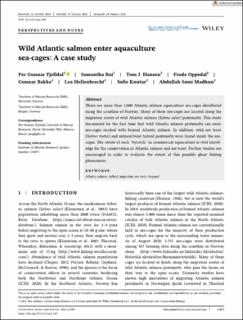| dc.contributor.author | Fjelldal, Per Gunnar | |
| dc.contributor.author | Bui, Samantha | |
| dc.contributor.author | Hansen, Tom Johnny | |
| dc.contributor.author | Oppedal, Frode | |
| dc.contributor.author | Bakke, Gunnar O | |
| dc.contributor.author | Hellenbrecht, Lea Marie | |
| dc.contributor.author | Knutar, Sofie | |
| dc.contributor.author | Madhun, Abdullah Sami | |
| dc.date.accessioned | 2022-02-07T14:20:25Z | |
| dc.date.available | 2022-02-07T14:20:25Z | |
| dc.date.created | 2022-01-26T10:05:53Z | |
| dc.date.issued | 2021 | |
| dc.identifier.citation | Conservation Science and Practice (CSP). 2021, 3 (5), 1-7. | en_US |
| dc.identifier.issn | 2578-4854 | |
| dc.identifier.uri | https://hdl.handle.net/11250/2977558 | |
| dc.description.abstract | There are more than 3,000 Atlantic salmon aquaculture sea-cages distributed along the coastline of Norway. Many of these sea-cages are located along the migration routes of wild Atlantic salmon (Salmo salar) postsmolts. This study documents for the first time that wild Atlantic salmon postsmolts can enter sea-cages stocked with farmed Atlantic salmon. In addition, wild sea trout (Salmo trutta) and salmon/trout hybrid postsmolts were found inside the sea-cages. The extent of such “bycatch” in commercial aquaculture is vital knowledge for the conservation of Atlantic salmon and sea trout. Further studies are encouraged in order to evaluate the extent of this possible ghost fishing phenomena. | en_US |
| dc.language.iso | eng | en_US |
| dc.title | Wild Atlantic salmon enter aquaculture sea-cages: A case study | en_US |
| dc.type | Peer reviewed | en_US |
| dc.type | Journal article | en_US |
| dc.description.version | publishedVersion | en_US |
| dc.source.pagenumber | 1-7 | en_US |
| dc.source.volume | 3 | en_US |
| dc.source.journal | Conservation Science and Practice (CSP) | en_US |
| dc.source.issue | 5 | en_US |
| dc.identifier.doi | 10.1111/csp2.369 | |
| dc.identifier.cristin | 1990137 | |
| dc.relation.project | Havforskningsinstituttet: 15697 | en_US |
| cristin.ispublished | true | |
| cristin.fulltext | original | |
| cristin.qualitycode | 1 | |
